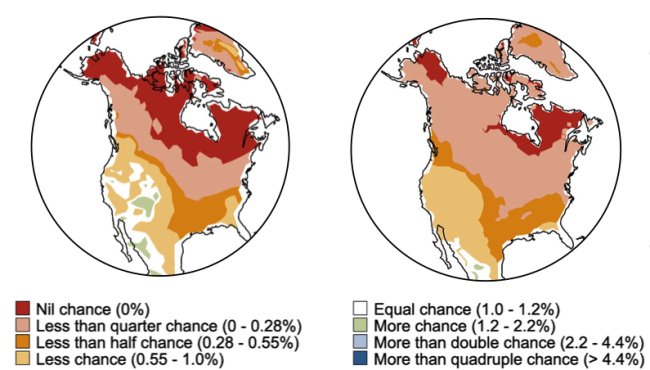Is the melting Arctic making cold US winters more likely?
In early January 2014, an Arctic air outbreak brought extreme cold and heavy snowfall to central and eastern North America, causing widespread disruption and monetary losses. The media extensively reported the cold snap, including debate on whether human-induced climate change was partly responsible. Related to this, one particular hypothesis garnered considerable attention: that rapid Arctic sea ice loss may be increasing the risk of cold extremes in the mid-latitudes. But do climate model projections provide any support for this hypothesis?

Figure 1. The change in the probability of the cold winter days over the US in 2090 relative to 1990, simulated by two independent climate models in response to projected Arctic sea ice loss.
Screen et al. 2015 used state-of-the-art climate model simulations to explore how the risk of North American daily cold extremes is anticipated to change in the future in response to increases in greenhouse gases. They find that the likelihood of North American cold extremes decreases in the future. Days as cold or colder than witnessed in winter 2013/14 are still projected to occur around the year 2050, albeit less frequently than now. However, such events will cease to occur by the year 2080, assuming greenhouse gas emissions continue unabated. The study also conducted experiments to isolate the fraction of this change that is solely due to Arctic sea ice loss. Projected Arctic sea ice loss alone reduces the odds of such an event (Figure 1): over much of North America the probability of such an event is more than halved by 2100. In more northerly regions, Arctic sea ice loss reduces the probability even more. In summary, contrary to recent claims, North American cold extremes are found to become less frequent as a result of continuing Arctic sea ice loss.
Reduced Risk of North American Cold Extremes due to Continued Arctic Sea Ice Loss (Bulletin of the American Meteorological Society)
1University of Exeter, UK
2National Center for Atmospheric Research
Topics
- Sea Ice
- Weather
- Climate Change
- Arctic
- Extreme Events
